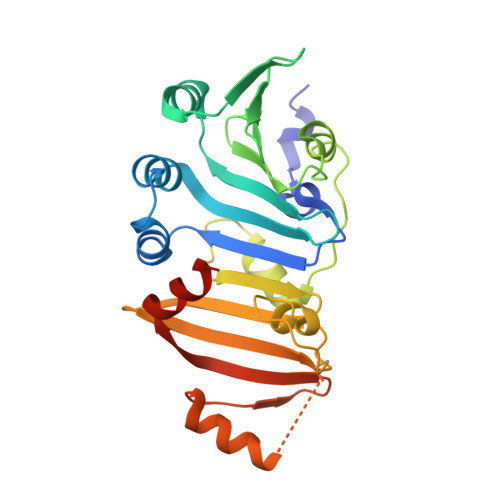The Transition from Closed to Open Conformation of Treponema pallidum Outer Membrane-associated Lipoprotein TP0453 Involves Membrane Sensing and Integration by Two Amphipathic Helices.
Luthra, A., Zhu, G., Desrosiers, D.C., Eggers, C.H., Mulay, V., Anand, A., McArthur, F.A., Romano, F.B., Caimano, M.J., Heuck, A.P., Malkowski, M.G., Radolf, J.D.(2011) J Biol Chem 286: 41656-41668
- PubMed: 21965687
- DOI: https://doi.org/10.1074/jbc.M111.305284
- Primary Citation of Related Structures:
3K8G, 3K8H, 3K8I, 3K8J - PubMed Abstract:
The molecular architecture and composition of the outer membrane (OM) of Treponema pallidum (Tp), the noncultivable agent of venereal syphilis, differ considerably from those of typical Gram-negative bacteria. Several years ago we described TP0453, the only lipoprotein associated with the inner leaflet of the Tp OM. Whereas polypeptides of other treponemal lipoproteins are hydrophilic, non-lipidated TP0453 can integrate into membranes, a property attributed to its multiple amphipathic helices (AHs). Furthermore, membrane integration of the TP0453 polypeptide was found to increase membrane permeability, suggesting the molecule functions in a porin-like manner. To better understand the mechanism of membrane integration of TP0453 and its physiological role in Tp OM biogenesis, we solved its crystal structure and used mutagenesis to identify membrane insertion elements. The crystal structure of TP0453 consists of an α/β/α-fold and includes five stably folded AHs. In high concentrations of detergent, TP0453 transitions from a closed to open conformation by lateral movement of two groups of AHs, exposing a large hydrophobic cavity. Triton X-114 phase partitioning, liposome floatation assay, and bis-1-anilino-8-naphthalenesulfonate binding revealed that two adjacent AHs are critical for membrane sensing/integration. Using terbium-dipicolinic acid complex-loaded large unilamellar vesicles, we found that TP0453 increased efflux of fluorophore only at acidic pH. Gel filtration and cross-linking experiments demonstrated that one AH critical for membrane sensing/insertion also forms a dimeric interface. Based on structural dynamics and comparison with Mycobacterium tuberculosis lipoproteins LprG and LppX, we propose that TP0453 functions as a carrier of lipids, glycolipids, and/or derivatives during OM biogenesis.
Organizational Affiliation:
Department of Medicine, University of Connecticut Health Center, Farmington, Connecticut 06030.














